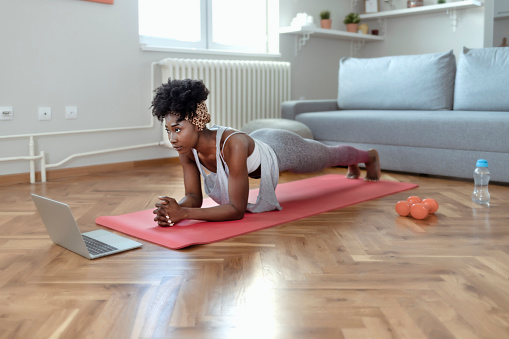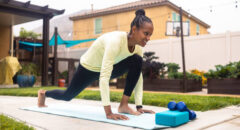
There’s a way to flatten your belly without the crunches.
Abdominal exercises are the most demanded. Everybody wants a flat stomach but most don’t like crunches, despite their place in most abdominal workouts. Well, there’s good news! You never have to do another crunch again.
The best move for flat, pulled-in abs is the plank. Here are three reasons a plank is more beneficial than a crunch:
1. The plank does more for your abdominal muscles.
To do a plank, get in a push-up position and lower your arms so your elbows rest on the ground.
Brace your abs in tight towards your back and engage your whole body by pressing your shoulders down your back and squeezing your legs together.
Hold for 45 seconds and be careful not to arch your back or stick your butt in the air.
A plank is superior because it causes a natural bracing/engagement of all four of your abdominal muscles (the transverse abdominis, rectus abdominis, internal and external obliques), whereas the crunch largely engages just one (rectus abdominis).
In addition, the abdominals receive both strengthening as well as aspects of flexibility through the plank.
The crunch is an isolated exercise, and it does its function well as a rectus abdominus strengthener.
But it’s far from functional, and for most people, far from what is needed for a healthy balanced body.
2. The plank is a multi-tasking move to flatten the belly without crunches.
Who does just one thing at a time in life anymore?
Why should your abs exercise be any different?
A crunch only works your abdominal wall, while a plank is a total body exercise that also engages your core (abs & lower back), helps better your posture, and works shoulder stabilization.
Plus, you never know when you are going to need to support your own weight and lift yourself off the floor.
3. The plank is better for your back and core.
A plank helps protect the back from problems that stem from sitting at a desk all day.
It strengthens the abs and core, while crunches exacerbate lower back issues.
Planks are ideal because they strengthen and stretch the body at the same time.
With a lengthened back and engaged glutes, you are able to integrate your core stabilizers which are critical for a healthy back and core.
How to do the Perfect Plank
1. Get Into (Correct) Position
The clue is in the name. To pull off a good plank you have to position yourself like one. Hold yourself up on the ground with your forearms and toes. Your back and legs should be as straight as possible. Clasp your hands if it helps you balance.
2. Go for at Least 60 Seconds
Do not be fooled – planks are hard work. The first 10 to 20 seconds may be a breeze but soon your forearms and toes will wobble and your abs will be on fire. While it is tempting to fall to the ground, hold your nerve. Sixty seconds is a good time to aim for when starting out.
3. Use the mirror
When the wobbles set in, it is tempting to move your knees and bottom for some relief. To avoid this, do the exercise in front of a mirror to ensure you are as plank-like as possible.
4. Don’t Forget to Breathe (Deeply)
You are doing the exercise with perfect form, aided by looking in the mirror, but after seeing your bulging and burning face staring back at you, you collapse to the floor in fright. To avoid this, breathe deeply. With your body clenched tightly, it is easy to start shallow breathing. Focus breathing into your stomach. This will also distract from the pain.
5. The Most Important Thing: Rest
You will be in pain the next day. Take is easy and do not force yourself to work out again straight away.









